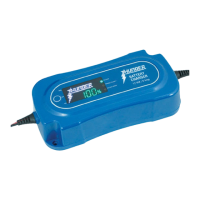5
Explanation of Stages
EXPLANATION OF STAGES
This charger automatically employs an 8 stage charging program. These stages automatically switch from one to the next without any user input required.
• Desulphation
In this initial start up stage, a high frequency voltage pulse assists in
“waking up” a deeply discharged battery. This method of pulse charging can
also help reduce the build up of sulfate crystals that may have formed on the
battery plates during the time it was discharged. This stage will last as long as
it takes the battery to reach approximately 10 volts. If the connected battery is
only slightly discharged, this stage may only be activated for a short time
before automatically switching to the next soft start stage.
• Soft Start
After the battery is connected most conventional “Smart” battery chargers
will immediately apply a high charging voltage and current output. This
creates a large amount of gassing and heat generated by the battery that can
cause individual battery cell voltages becoming uneven. Uneven cell
voltages can cause individual cell overcharging or undercharging, lessening
the overall life span of your battery. The soft start function eliminates this by
starting the charge process slowly. Battery electrolyte and cell voltage is
given a chance to even out prior to the main bulk charging processes,
greatly increasing the batteries charging capability.
• Bulk
This is the main hard charging stage, where the charger will operate at its
maximum output current and voltage until it reaches the correct levels as
required from the selection made with the chemistry button (different
battery types require different charge levels). The charging period of this
stage is determined by the capacity and charge state of the connected
battery and will fluctuate between different battery types.
• Absorption
After the bulk stage, the charger will automatically begin to reduce its current
output whilst maintaining the required voltage (depending on the chemistry
of the battery). When the current reaches a pre-determined threshold level,
charging will halt allowing the next analysis stage to be performed.
• Analysis (Testing the battery whilst charging)
After the absorption stage, the battery charger will start the analysis stage
and will stop charging the battery for approximately one minute. At this
point, if the battery voltage drops too quickly past set parameters the battery
error indicator (red LED) will be flashing, your battery may be faulty. Please
see your local auto electrician to have your battery evaluated. If the battery
passes this test without any faults detected, it will then move to the boost
stage.
• Boost
After a successful result from the analysis stage, the charger will now
enter the Boost stage where voltage is increased to maximum and the
current is reduced to approximately 25% of the rated output. This stage
brings the battery safely up to a 100% fully charged state.
• Float
This stage provides a constant voltage to the battery compensating for
temperature and self-discharge of the battery.
• Maintenance
This stage evens out voltage between all cells and will maintain a constant
pulse voltage with a very small current. This stage will remain on indefinitely
whilst the battery is connected and is perfect for long term maintenance
for vehicles or stand-alone batteries that will not be used for long periods of
time such as winter storage. Keeping your battery on a maintenance charge
will ensure it is always 100% charged and in turn will reduce the chance of
sulfation, extending battery life and serviceability. During long term
maintenance, it is important to periodically check fluid levels in the battery
if it is NOT a sealed or maintenance free design.

